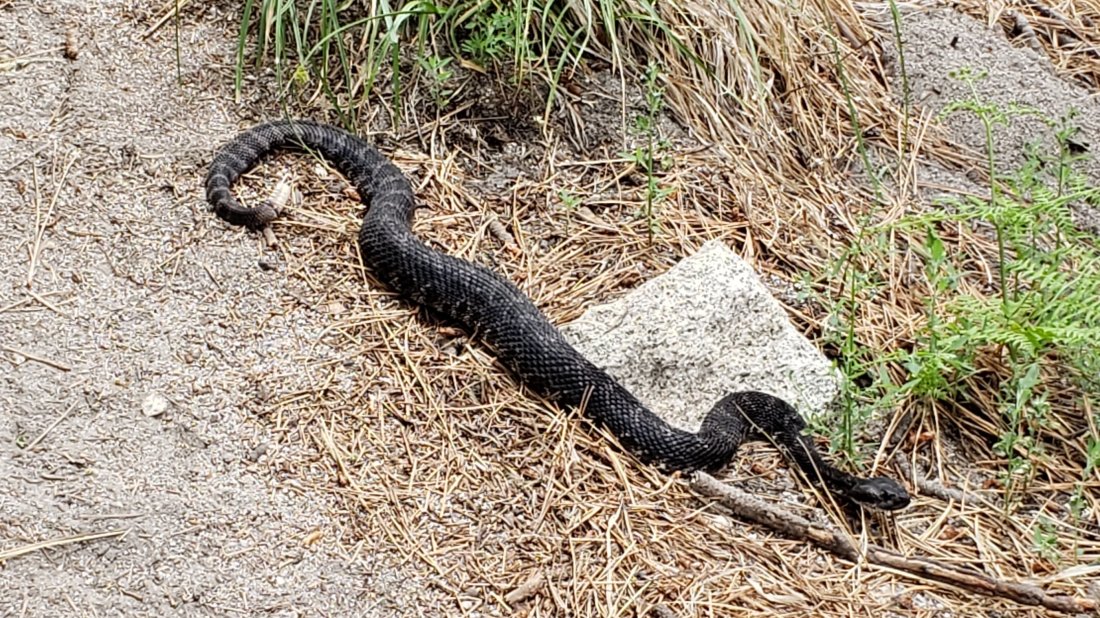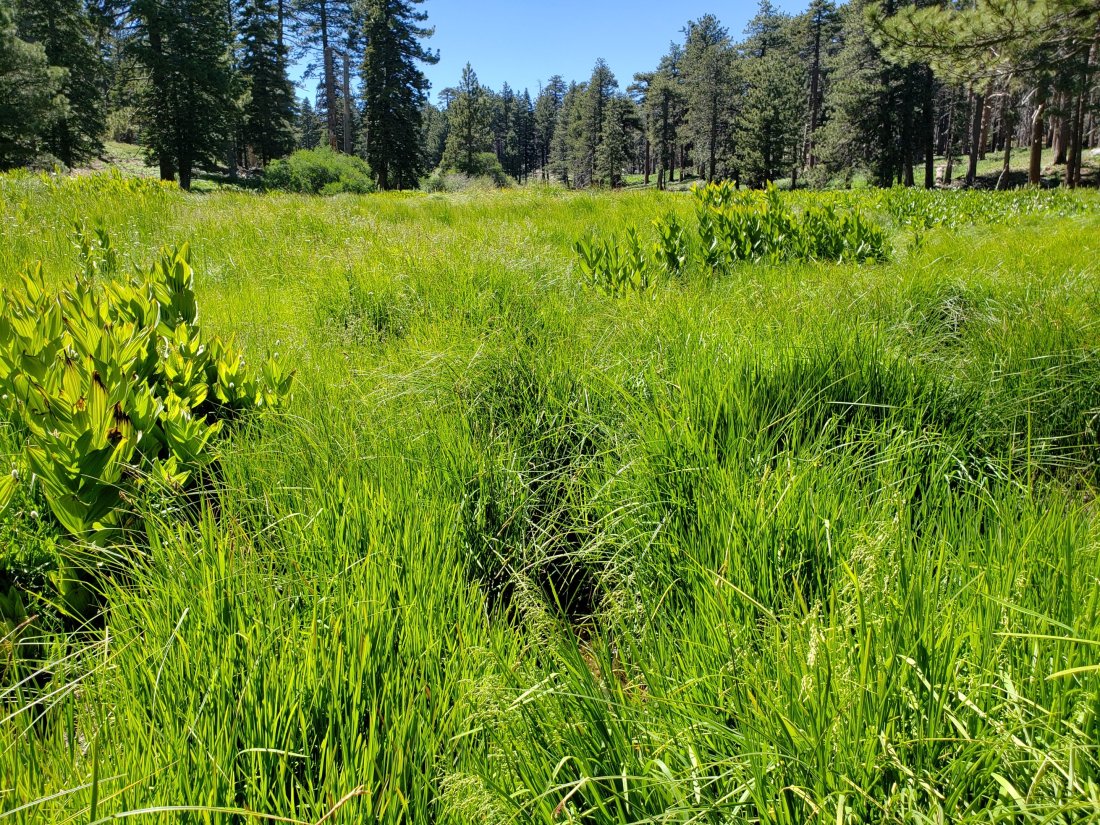A long day yesterday included surveying trails east, west, and south of San Jacinto Peak, having checked water sources throughout the Tahquitz area meadows last week. The status of all major water sources, trails, and road access, are detailed below.
As reported last week, closures to the Boulder Basin and Black Mountain Group campgrounds (both accessed from Black Mountain Road), and Dark Canyon Road, will remain in place through this year.
Hikers should always be prepared for rapidly changing weather conditions in the high country in summer. Monsoonal conditions, most often in the afternoons, are possible for the foreseeable future. Thunderstorms with lightning, precipitation, and rapid temperature drops, can occur in the high country even when such storms are not forecast for lower elevations.

We are encountering Southern Pacific Rattlesnakes on the trails every week at present. This one was on the PCT near Strawberry Cienega on 24th July.
WEATHER Humid monsoonal conditions with summer temperatures took hold a few days ago. In Idyllwild it has tried to rain each day since Monday (<0.01″ each day). There have also been localised showers throughout the high country each day, but the intense thunderstorm cells have so far been at lower elevations. To date, Wednesday 12th June remains the warmest day of the year recorded at San Jacinto Peak.
At San Jacinto Peak (10,810’/3295m) yesterday 24th July 2019 at 0720, the air temperature was 52.3°F (11°C), with a windchill temperature of 47.4°F (8°C), 66% relative humidity, and a light SE wind at 4 mph gusting to 11.2 mph.
At the Peak on 18th July 2019 at 0800, the air temperature was 51°F (11°C), with a windchill temperature of 43°F (6°C), 12% relative humidity, and a stiff SSW wind at 18 mph gusting to 25.2 mph.

Shaggy-haired Alumroot (Heuchera hirsutissima) at 9900′ near Little Round Valley, 24th July 2019.
TRAIL CONDITIONS
All trails, including the entire Pacific Crest Trail throughout the San Jacinto mountains, have been free of snow since the end of June.
The Pacific Crest Trail remains open at the rockslide near Antsell Rock (Mile 172.5). The video report from late May (available here) may be useful for deciding whether to try to hike around the rockslide.
With the closure of Dark Canyon Road, Dark Canyon campground is also closed, and there is no vehicular access to Seven Pines trailhead (although the road is hikeable of course, 3.5 miles each way).
Willow Creek Trail has had most obstructing trees removed, and there are now only five trees down on the trail between Willow Creek and Hidden Divide (four on USFS land and one on State Park). This is a huge improvement from the nearly 30 trees down on this trail in early June. However a couple of the remaining trees can be challenging to hike around (or over, depending on one’s abilities).
I surveyed Seven Pines Trail in mid June and it had 35 trees down, almost all above 7500′ elevation. This trail has been very lightly traveled since 2018, and is indistinct in places. Hikers without considerable prior experience of this trail should take great care with routefinding.
The Caramba Trail from near Reeds Meadow through Laws Camp to Caramba, and the Cedar Trail from Willow Creek Trail to Laws, are not maintained. Signage to this effect has been in place since the end of June. Both trails are very indistinct in places, and hikers without considerable prior experience of this area should use cautious navigation.
WATER STATUS: Eastern slope
The Round Valley spigot is flowing well at about 2.0 gpm.
Both the northern and southern springs at Wellman’s Cienega are flowing well, but flow rates have dropped dramatically this month.

Wellman’s Cienega North spring, 24th July 2019.
These springs are the sources for Willow Creek, which is flowing very well where it crosses the Willow Creek Trail.
Tahquitz Valley is still flowing well where it crosses the meadow trail.

Tahquitz Valley, where the trail crosses the creek, 16th July 2019.
Tahquitz Creek is flowing strongly at the northern end of Little Tahquitz Meadow. It is also flowing well further upstream at its source (known locally as Grethe Spring) where it crosses the PCT (approx. PCT Mile 177).

Tahquitz Creek at the north end of Little Tahquitz Valley (above), and where it crosses the PCT just below its source at Grethe Spring (below), 16th July 2019.

Candy’s Creek – that flows through Skunk Cabbage Meadow and then crosses the Caramba Trail near Reeds Meadow – is flowing gently, but is very overgrown with thick vegetation, and is too shallow for easy filtering.

Skunk Cabbage Meadow at the creek crossing, 16th July 2019.
WATER STATUS: Western slope
The North Fork of the San Jacinto River is flowing very well where it crosses the Deer Springs Trail and even better where it crosses the Fuller Ridge Trail on the PCT (approx. PCT Mile 186.0).

North Fork of the San Jacinto River at Deer Springs Trail, 24th July 2019.
O’Sullivan Creek (PCT Mile 186.4) on Fuller Ridge Trail is flowing well.
The creek in Little Round Valley is flowing the strongest I have seen in at least six years, but flow rate has dropped dramatically this month.
Shooting Star Spring (below Little Round Valley but above the North Fork of the San Jacinto River crossing) is flowing well.
The Deer Springs stream crossing at the PCT (approx. PCT mile 185) is flowing strongly.
Switchback Spring (about 0.4 miles north of Strawberry Junction) is now flowing only gently, but there is very little depth in which to filter water.
The little creek at Strawberry Cienega is flowing gently. However the tiny pool between the rocks, good for filtering, was filled with sediment over the winter.

Strawberry Cienega, 24th July 2019.
On Devil’s Slide Trail, Middle Spring is flowing gently, but flow rate is greatly diminished. Powderbox and Jolley springs, and the several unnamed ephemeral creeks on this trail, dried up several weeks ago.
On the Ernie Maxwell Trail, the crossing of Chinquapin Creek just below Humber Park continues to flow very well (an important source of water for the many dogs walked on this trail).
WATER STATUS: Desert Divide
Live Oak Spring (N 33 37 21, W 116 33 24) Flowing well. The most reliable water source on the Desert Divide.
Cedar Spring (N 33 40 36, W 116 34 35) Flowing well. Easiest access is the trough just upstream from the trail to the campsite.
Apache Spring (N 33 43 11, W 116 37 13) Flowing fairly well. See comments above regarding the greatly improved trail to this spring.
Spitler Peak Trail Descending this trail from the PCT there are five water crossings. The first two, at 0.9 and 0.95 miles down, cross a tiny side creek which is largely dry and should be ignored. The next three crossings, at 1.1 to 1.3 miles down, are Spitler Creek, which is currently flowing well.
Antsell Rock Creek (N 33 41 52, W 116 39 08) Right by the Spitler Peak Trail trailhead on Apple Canyon Road, Antsell Rock Creek is flowing very well. Just on the upstream side of the road there is excellent access to the creek. Useful if hikers are descending the Spitler Peak Trail.
ACCESS CLOSURES The Valentine’s Day flood events continue to make access to the San Jacinto mountains challenging. In the past week even the open sections of Highways 74 and 371 have been closed briefly for roadside fires, so always be prepared for additional delays. Highway 243 between Banning and Idyllwild is closed from Skyland Ranch (north of Bay Tree Spring) to just north of Lake Fulmor. The remaining closed section may not reopen until 2020. Highway 74 between Mountain Center and Hemet is currently open with a pilot car and restricted hours (0400-0800, 1800-0000) on weekdays, and broader hours (0400-0000) on weekends and holidays. It may reopen in September but still with a flagman and partial single lane traffic.
Thank you so very much! This comes from one who can’t get there ❤️ Joan
LikeLike